5.8 Bloomberg Module
The Bloomberg module allows the collection of Bloomberg IM and Mail messages from the daily FTP downloads allowed from the Bloomberg System.
As electronic business communications, Bloomberg Mail is subject to the same compliance regulations as other electronically stored information. Potential litigation makes it critical for companies to archive this data and make it available for discovery. The U.S. Securities and Exchange Commission (SEC) also mandates retention.
5.8.1 Prerequisites
On the Bloomberg server create a user that Retain can use to log into the Bloomberg SFTP server.
5.8.2 Module Configuration
The module must be configured before archiving may occur.
5.8.3 Core Settings tab
The module needs to be enabled on this page to make it active in the Retain system.
The module can be given a name.
The Send Method option enables either the SMTP Forwarding or FTP features. For either feature to appear and function, the Module Forwarding tab must be configured on the Server Configuration page. See that section for more information.
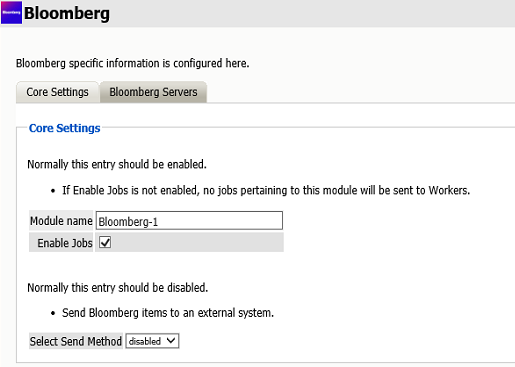
Select Send Method: Send Bloomberg items to an external system via FTP or SMTP. Normally this entry should be disabled.
5.8.4 Bloomberg Servers tab
Add Bloomberg Server: Click on the green plus sign to add a Bloomberg server to download from. Multiple servers can be added.
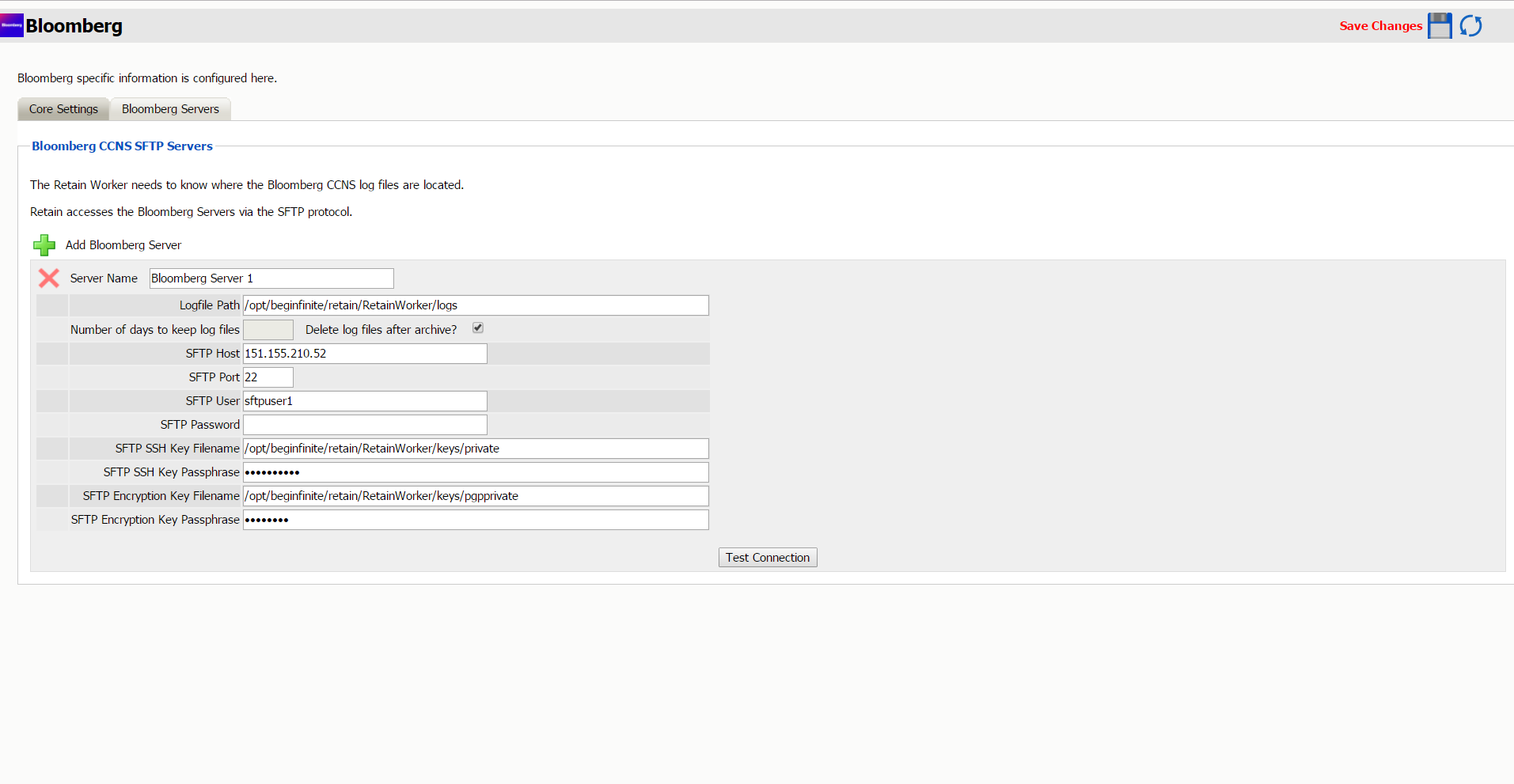
Server Name: The name Retain will use to reference Bloomberg messages. You can use any name you wish.
Logfile Path: Where the worker will transfer the logfiles to locally before processing. The log file path must be unique for each server.
Delete log files after archive?: By default, Retain processes and archives the log files, keeping the log files in the Logfile Path directory indefinitely. Disabling this option allows you to set the Numbers of days to keep Logfiles option.
Number of days to keep Logfiles: How many days to keep the files downloaded from Bloomberg before Retain deletes the logfiles from the log file directory. 0 means never delete the files.
SFTP Host: The IP address or hostname of the Bloomberg server.
SFTP Port: Port 22, by default, but can be changed by the admin.
SFTP User: This user is created on the Bloomberg server by the Bloomberg server administrator. The user can authenticate either through password or SSH using a private key.
SFTP Password: This password is created on the Bloomberg server.
SFTP SSH Key Filename: The local path to the SSH key file downloaded from the Bloomberg Server.
SFTP SSH Key Passphrase: Created on the Bloomberg server.
SFTP Encryption Key Filename: The local path to the Encryption key file downloaded from the Bloomberg Server.
SFTP Encryption Key Passphrase: Created on the Bloomberg server.
5.8.5 Bloomberg Profile
The Profile allows you to set what is to be dredged from your Bloomberg system.
Click on “Add Profile” and provide a profile name, or select an already existing profile to access the configuration tabs. All changes made on this page must be saved by selecting the “save changes”, disk icon, at the top right of the page. Tabs may be changed and navigated through without affecting new settings, but any move to another page will require saving, or abandoning the changes made.
Core Settings tab
Core settings allow you to enable archiving.
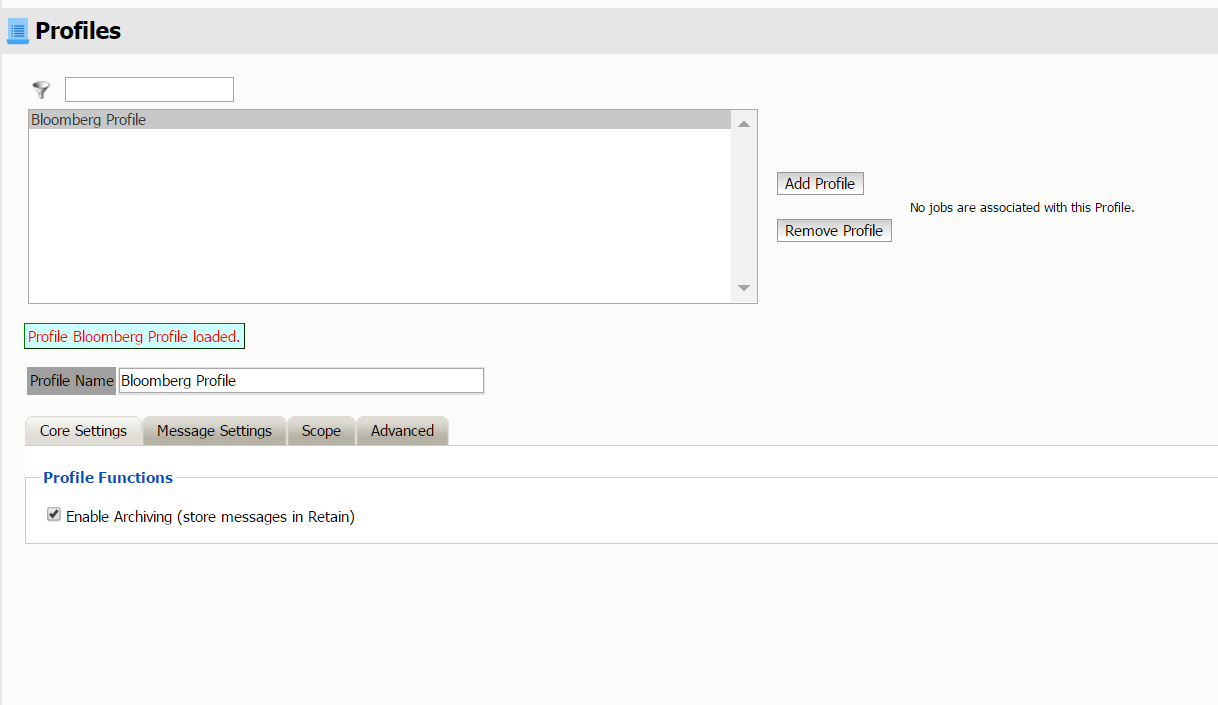
5.8.6 Profile Functions
The Profile Functions tell the Retain Server what to do with the mail it archives from the Bloomberg system. If Archiving is not enabled, mail will not be archived by Retain.
Message Settings tab
The message settings tab allows you to restrict the types of messages to be archived.
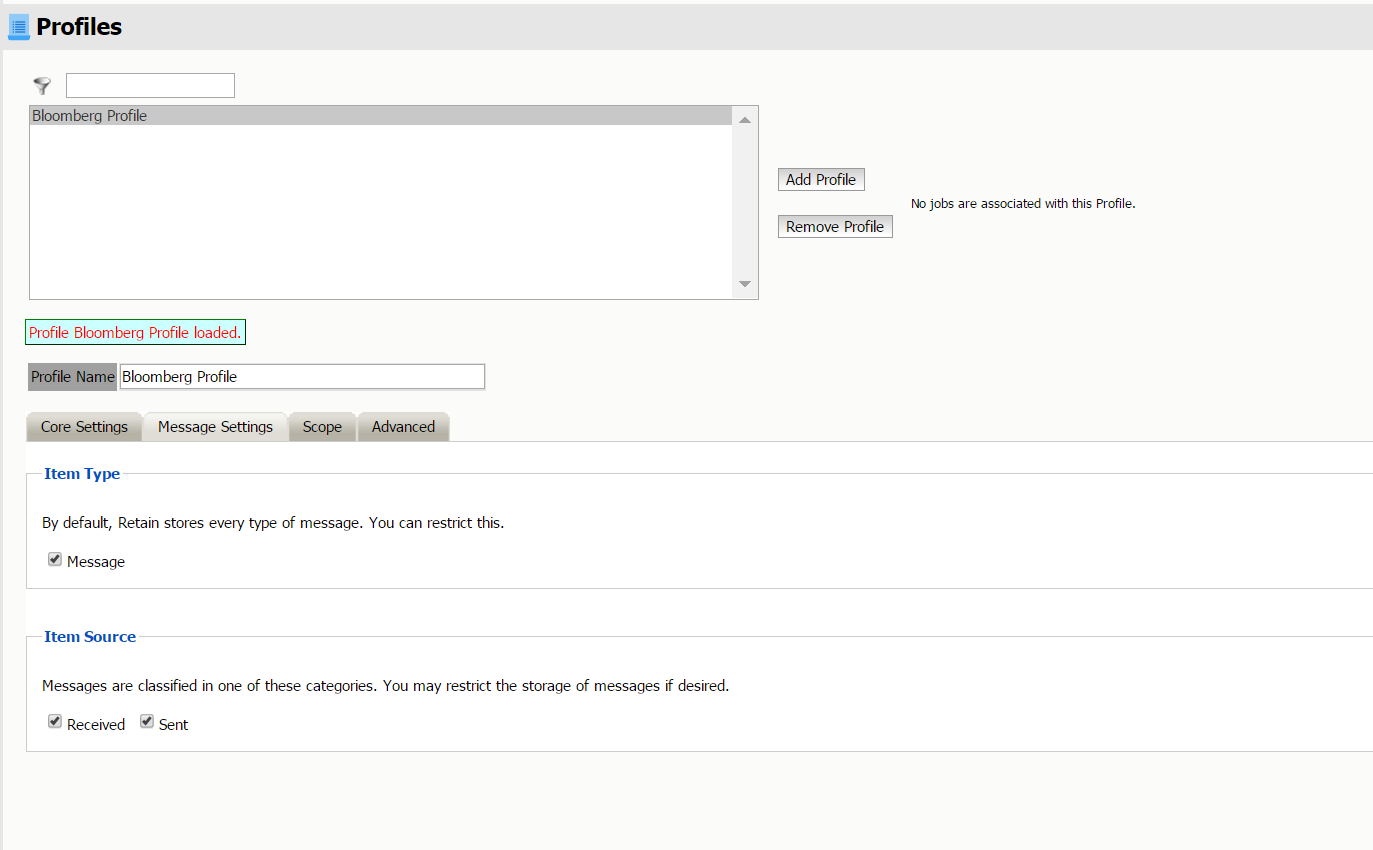
There is only one type of message, disabling this will prevent archiving. You can restrict the item source to received or sent items only or both.
By default, all items are selected for collection.
5.8.7 Scope tab
This is the most critical tab to fill out as it sets the limits on how much to archive.
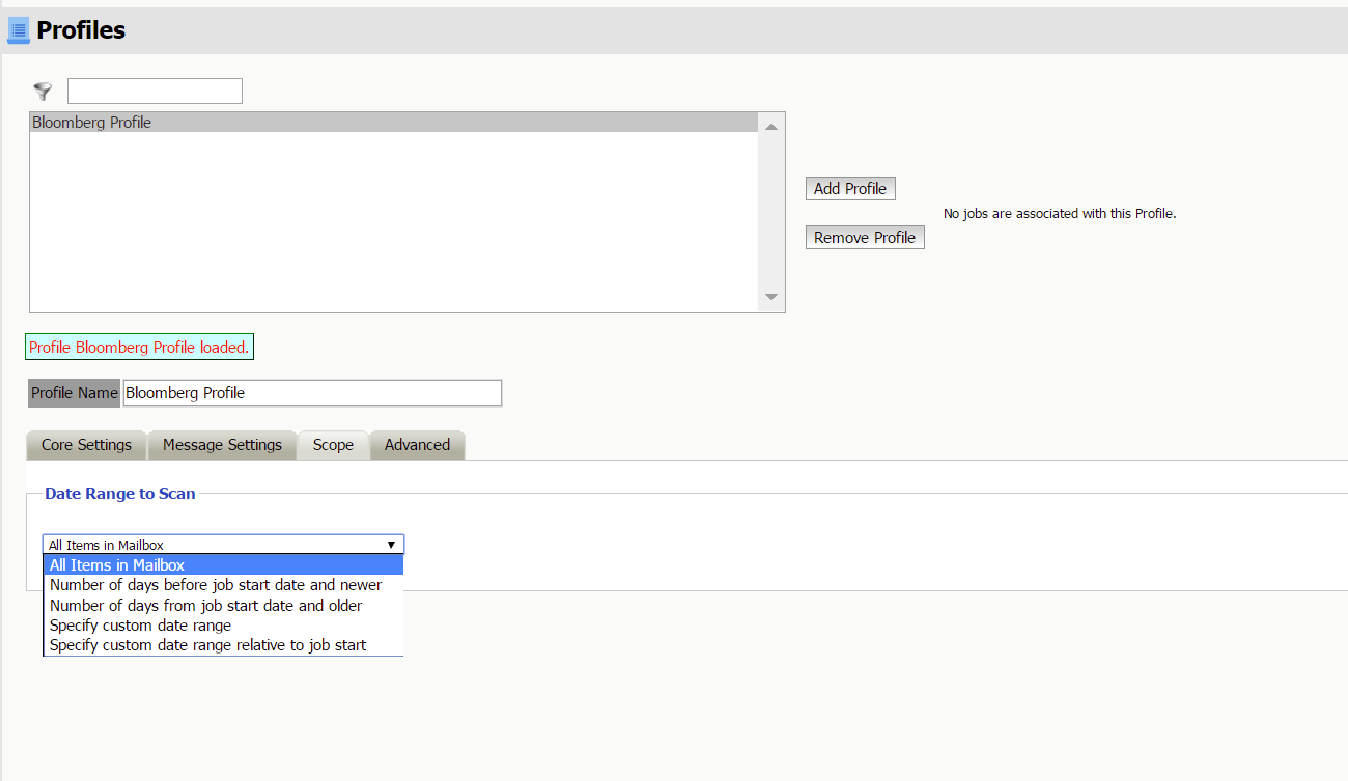
5.8.8 Date Range to Scan
The Date Range determines which message items are collected, depending on the date of the message.

All Items in Mailbox: All items in the mailbox starting from 1/1/1970, duplicates will be processed but not stored if they already exist in the Retain archive.
Number of day before job start date and newer: Only items from the relative number of days from the time the job began will be archived. E.g. messages that came into the email system 7 days ago or less.
Number of days from job start date and older: Only items previous to the relative number of days from the time the job began will be archived. E.g. messages that came into the email system 7 days ago or more.
Specify custom date range: Only items between two absolute dates will be dredged.
Specify custom date range relative to job start: Only items between two relative dates will be dredged. E.g. messages that came into the email system between 7 and 5 days ago.
5.8.9 Advanced
The Advanced tab allows you to limit what is stored by Retain. This must be used with caution as this opens holes for data to be lost through. It is recommended to store everything since storage space is inexpensive.
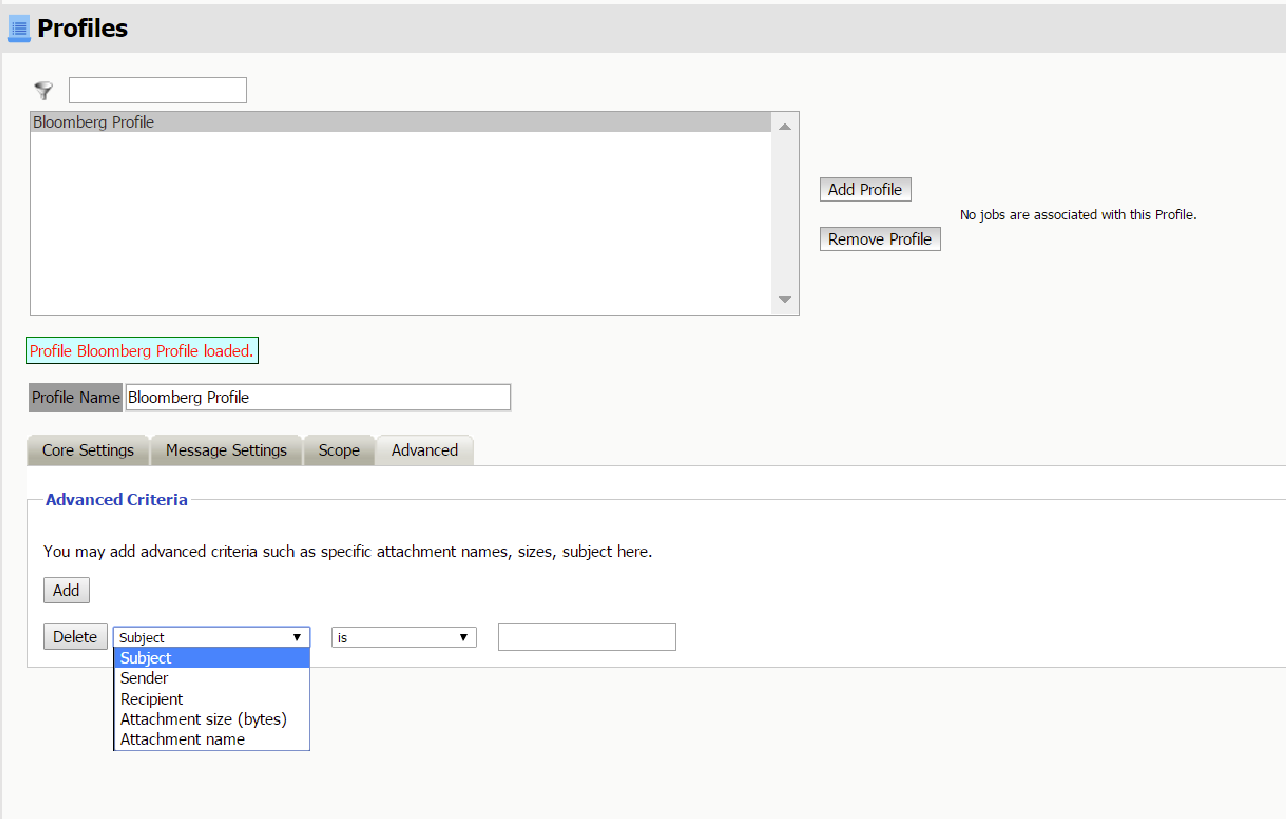
Advanced Criteria
If you want to be more specific as to what to dredge or not to dredge, add the criteria here. Each line will be logically AND-ed together. Think “Dredge all items where the following is true:” Criteria A AND Criteria B AND Criteria C AND etc.

You may select based on:
-
Subject
-
Sender
-
Recipient
-
Attachment Size (in bytes)
-
Attachment Name
-
Category
And whether they are equal to, not equal to, contain or do not contain the item you specify.
This gives you great flexibility and granularity. It allows you to customize dredges and retention for many different groups, or even individuals.
You may now configure Schedules, Workers and Jobs.